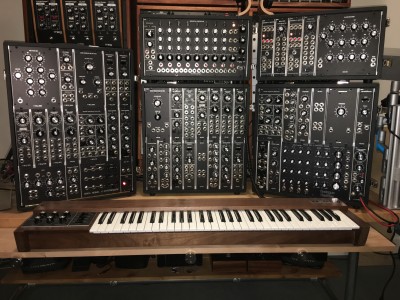First, I recommend looking at Dave Brown's Modular Synthesis site:
https://www.modularsynthesis.com/moog/moog.htm
He has some great photographs of some Moog modular restorations he's done with other useful information.
On this page, he details making a Dot Com cabinet adapter.
https://www.modularsynthesis.com/moog/p ... _power.htm
Here are the Mouser links for the Moog connector hardware:
https://www.mouser.com/ProductDetail/571-5-530501-5
https://www.mouser.com/ProductDetail/571-582388-9
They don't have the 571-5-530505-5 pins anymore.
Tool for pin extraction, ridiculous price
 https://www.mouser.com/ProductDetail/571-810992-1
https://www.mouser.com/ProductDetail/571-810992-1
The connectors are straight forward to wire and assemble. If you want to move standard Moog modules around, just be sure to add any extra inter module "hard" wiring, like between a VCO driver and the slave VCOs.
With regard to power, I'm quite certain my Model 15 uses an "off the shelf" linear supply; looks like a Power One, now called Bel Power Solutions, or something very comparable. They are nice and come in a lot of different configurations. They are "bare" and require you to add a power cord, connectors, fuses, etc. and you will have to be sure to take all safety precautions recommended as you will have "mains" voltage present in your cabinet. You probably won't find a +12/-6, but one of their engineers explained how to make my +/-12 supply into a +12/-10 supply. You might be able to make it a +12/-6, too if you have the motivation. An easier option is to buy a +/-15 and do an adapter like Dave Brown. Dave used adjustable regulators (I prefer adjustable regulators, too). Remember Moog uses several voltages depending on the module so make sure you are providing the correct and all the proper voltages. Note that Dave's adapter provides +12, -10 and -6 volts from the +/- 15 supply for the particular modules he had to power. If you use adjustable regulators, remember you have to have a minimum load on the regulator before it starts to work and before you can adjust it.
Synthesizers Dot Com use a small switching supply for small systems, and what looks like a Bel Power Solutions linear for their larger systems. I have some of both. Roger makes very high quality stuff and is a great person to work with.
Gerhard at Synth-Werk makes excellent gear and I can't recommend it highly enough. I purchased a lot of modules from him to expand my Model 15 and they are amazing! His modules all have on board regulators and mate with a standard Dot Com power supply and connector. He also knows exactly how to integrate his modules into vintage or the re-issued Moog systems and has instructions that come with his modules where needed. In addition to other modules, I put one of his 921-B VCOs in my Model 15 to make the Model 15's a trio of 921-Bs instead of just two slave VCOs. It was simple and completely reversible to do this. Right now, I have his other modules in some Dot Com "Moog" cases, but I also just got on Gerhard's list for a sequencer compliment, another full size portable power cabinet with some console modules, and two one module high, 8U expansion cabinets. I don't know how Gerhard handles power in his new full size portable cabinets.

Bottom line, you have several options for powering your expansion cabinet. Use an "off the shelf" +/- 15 like the Dot Com ones or a bare Bel Power solutions then use Dave Brown's adapter. Synth-Werk has a 22U powered expansion cabinet you could also use with an adaapter.
https://synth-werk.com/content/wooden-and-tolex-cases
Dot Com has a non-powered 22U cabinet:
https://synthesizers.com/studiocabinets.html
Dave's adapter is a clean and pretty simple solution. You could also put together a different distribution than the Dot Com compatible connectors on Dave's adapter like the screw terminals Moog used. Dot Com uses individual cables all connected with wire nuts through one main supply cable to the main power distribution terminals.
I think there are a lot of options open to you with the main obstacle of cost

David